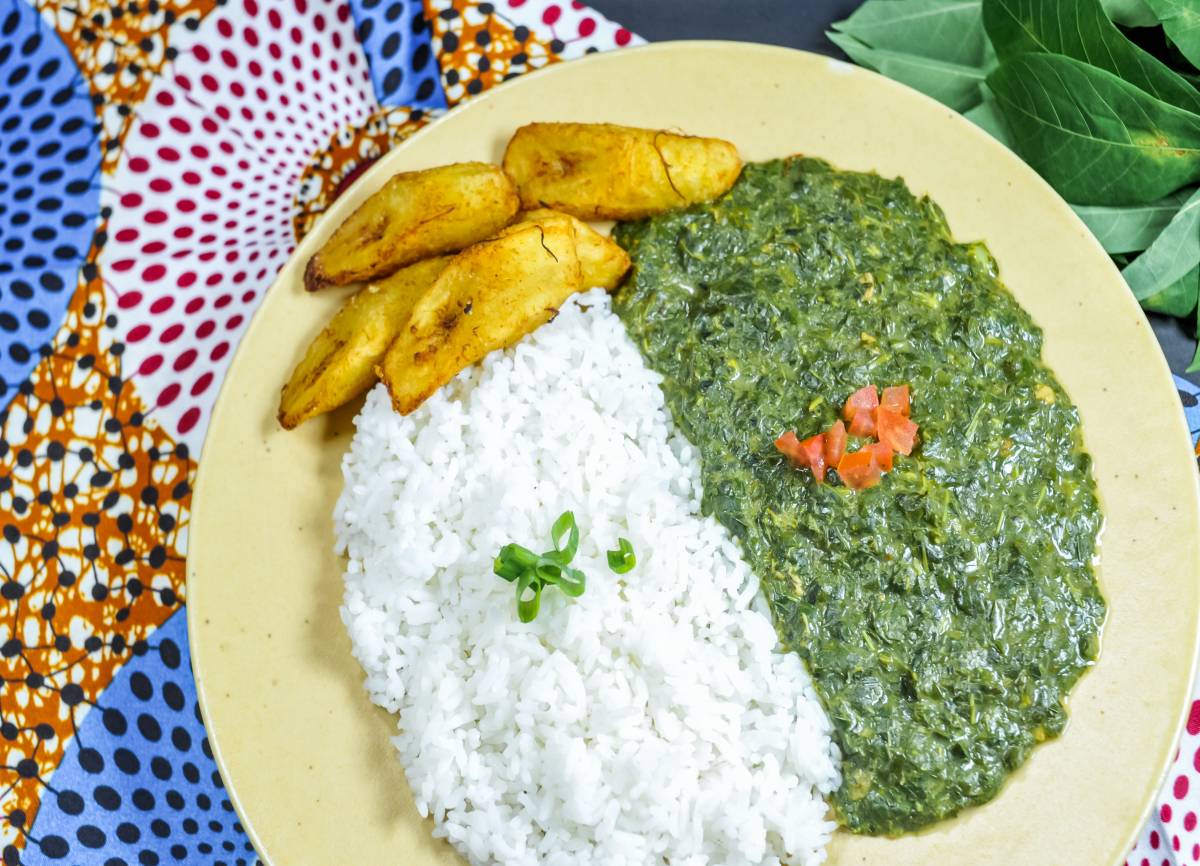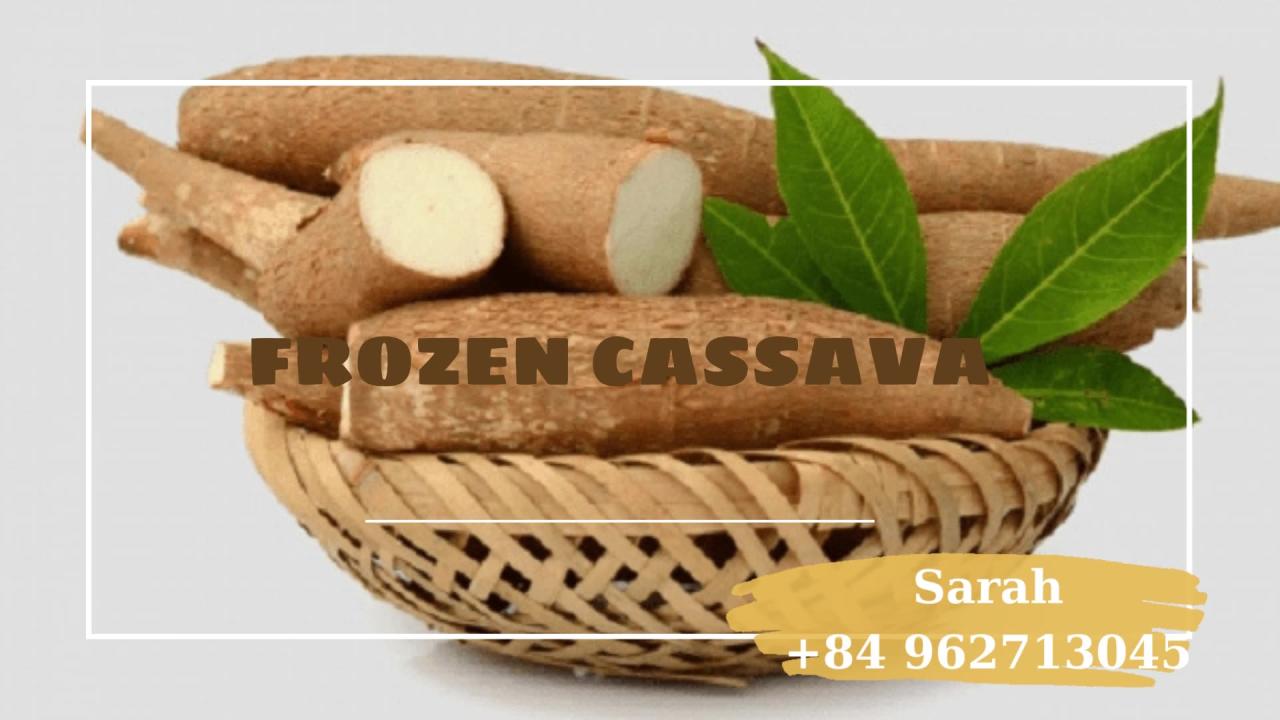Why Cassava Leaf is a Must-Have Ingredient in Your Healthy Recipes? This often-overlooked green is a nutritional powerhouse, offering a wealth of vitamins, minerals, and antioxidants. Beyond its impressive nutrient profile, cassava leaf boasts a unique versatility in the kitchen, lending itself to diverse culinary traditions and flavor profiles.
From traditional African dishes to modern vegan recipes, cassava leaf proves to be a truly adaptable ingredient.
Beyond its culinary appeal, cassava leaf offers a range of health benefits. Studies have shown its potential to boost immunity, manage blood sugar levels, and even promote heart health. Its abundance, affordability, and sustainable cultivation make it a valuable resource for promoting both personal well-being and global food security.
Nutritional Powerhouse
Cassava leaves, often referred to as “cassava greens,” are a nutritional powerhouse packed with essential vitamins and minerals. While they might not be as widely known as other leafy greens like spinach or kale, they offer a unique blend of nutrients that make them a valuable addition to any healthy diet.
Nutritional Profile of Cassava Leaves
Cassava leaves are an excellent source of various essential nutrients, including vitamins A, C, and K, as well as minerals like iron, calcium, and potassium. They are also rich in dietary fiber, which is crucial for digestive health.
Comparison to Other Leafy Greens
When compared to other popular leafy greens, cassava leaves stand out for their high protein content. They are also a good source of vitamin B9 (folate), which is essential for cell growth and development.
Nutrient |
Cassava Leaves (100g) |
Spinach (100g) |
Kale (100g) |
|---|---|---|---|
Protein (g) |
3.5 |
2.9 |
3.7 |
Vitamin A (IU) |
2,000 |
9,000 |
10,000 |
Vitamin C (mg) |
50 |
28 |
89 |
Iron (mg) |
3.0 |
3.6 |
2.0 |
Calcium (mg) |
100 |
296 |
147 |
Cassava leaves are an excellent source of protein, making them a valuable addition to vegetarian and vegan diets.
Culinary Versatility

Cassava leaves, a nutritional powerhouse, are also remarkably versatile in the culinary world. Their distinct flavor and texture make them a staple ingredient in various cuisines, adding depth and complexity to dishes.
Traditional Recipes
Cassava leaves are a cherished ingredient in many traditional cuisines, especially in Africa, Asia, and South America. Here are a few examples:
- Egusi Soup (Nigeria):This rich and flavorful soup features cassava leaves as a key ingredient, providing a unique texture and earthy taste. Egusi soup is often made with melon seeds, beef, and other vegetables, creating a hearty and satisfying meal.
- Afang Soup (Cameroon):Another popular soup, Afang soup, uses cassava leaves alongside Afang leaves, a type of leafy green. The soup is typically prepared with seafood, meat, or vegetables, resulting in a flavorful and nutritious dish.
- Lahu (Thailand):This stir-fried dish combines cassava leaves with garlic, chili peppers, and other spices, creating a spicy and aromatic meal. Lahu is often served with rice or noodles.
Preparation Methods
Cassava leaves can be prepared in various ways, each adding a unique flavor and texture to the dish.
- Steaming:Steaming is a popular method for preserving the leaves’ nutritional value and creating a tender texture. Steamed cassava leaves can be served as a side dish or used as an ingredient in soups and stews.
- Stir-frying:Stir-frying is a quick and easy way to cook cassava leaves, adding a flavorful twist. The leaves are often stir-fried with garlic, ginger, and other spices, creating a delicious and aromatic dish.
- Soups:Cassava leaves are a common ingredient in soups, adding a unique flavor and texture. They can be added to vegetable soups, meat soups, or seafood soups, creating a nutritious and satisfying meal.
Flavor Profiles and Compatibility
Cassava leaves have a slightly bitter and earthy flavor, which can be balanced by the addition of other ingredients. They are particularly compatible with:
- Spices:Garlic, ginger, chili peppers, and other spices can enhance the flavor of cassava leaves, creating a more complex and aromatic dish.
- Seafood:Cassava leaves pair well with seafood, creating a light and flavorful dish. They are often used in seafood soups and stews.
- Meat:Cassava leaves can also be used in meat dishes, adding a unique flavor and texture. They are often used in stews, curries, and other meat-based dishes.
Diverse Recipes, Why Cassava Leaf is a Must-Have Ingredient in Your Healthy Recipes
Recipe |
Ingredients |
Preparation |
|---|---|---|
Egusi Soup (Nigeria) |
Cassava leaves, egusi seeds, beef, onions, tomatoes, pepper, stock |
Boil the beef until tender. Add the egusi seeds and cook until they release oil. Add the onions, tomatoes, and pepper, and cook until softened. Add the cassava leaves and cook until tender. Season with salt and pepper to taste. |
Afang Soup (Cameroon) |
Cassava leaves, Afang leaves, seafood or meat, onions, tomatoes, pepper, stock |
Boil the seafood or meat until tender. Add the Afang leaves and cassava leaves, and cook until tender. Add the onions, tomatoes, and pepper, and cook until softened. Season with salt and pepper to taste. |
Lahu (Thailand) |
Cassava leaves, garlic, chili peppers, fish sauce, oyster sauce, soy sauce |
Stir-fry the garlic and chili peppers until fragrant. Add the cassava leaves and cook until tender. Season with fish sauce, oyster sauce, and soy sauce. Serve with rice or noodles. |
Health Benefits

Cassava leaves, often referred to as “green leaves” or “cassava tops,” are a nutritional powerhouse that offers a range of health benefits. Beyond their impressive nutrient profile, these leaves are packed with antioxidants, vitamins, and minerals that contribute to overall well-being.
Boosting Immunity
Cassava leaves are rich in vitamin C, a powerful antioxidant known for its role in bolstering the immune system. Vitamin C helps to protect the body against infections by supporting the production of white blood cells, which are essential for fighting off pathogens.
Additionally, the presence of other antioxidants, such as flavonoids and carotenoids, further enhances the leaves’ ability to strengthen the immune system.
Managing Blood Sugar Levels
Cassava leaves have demonstrated potential in managing blood sugar levels, making them a valuable addition to the diet of individuals with diabetes or those at risk of developing the condition. The leaves contain compounds that help regulate insulin sensitivity, improving the body’s ability to utilize glucose effectively.
Studies have shown that consuming cassava leaves can lead to a reduction in blood sugar levels, particularly in individuals with type 2 diabetes.
Promoting Heart Health
The abundance of antioxidants in cassava leaves plays a crucial role in promoting heart health. These antioxidants help to combat oxidative stress, which can damage blood vessels and contribute to cardiovascular disease. Additionally, cassava leaves are a good source of potassium, a mineral that helps regulate blood pressure and reduces the risk of stroke.
Potential Risks and Side Effects
While cassava leaves offer numerous health benefits, it’s important to note that there are potential risks and side effects associated with their consumption.
Cyanide Content
Cassava leaves contain cyanogenic glycosides, which can release cyanide upon processing or consumption. Cyanide is a toxic substance that can interfere with cellular respiration. However, proper preparation methods, such as boiling or drying, can significantly reduce the cyanide content.
Allergic Reactions
Some individuals may experience allergic reactions to cassava leaves, manifesting as skin rashes, itching, or digestive issues. It’s crucial to start with small portions and monitor for any adverse reactions.
Interactions with Medications
Cassava leaves may interact with certain medications, particularly blood thinners and medications used to treat diabetes. It’s essential to consult with a healthcare professional before incorporating cassava leaves into your diet, especially if you are taking any medications.
Summary of Health Benefits and Potential Risks
Benefit |
Risk |
|---|---|
Boosts immunity through vitamin C and antioxidants |
Cyanide content (reduced by proper preparation) |
Helps manage blood sugar levels |
Allergic reactions in some individuals |
Promotes heart health with antioxidants and potassium |
Potential interactions with medications |
Sustainable Source of Nutrition

Cassava leaves, often overlooked as a food source, are a nutritional powerhouse that offers a sustainable and affordable solution to dietary needs, particularly in regions where food security is a challenge. Their accessibility and affordability make them a valuable asset in promoting healthy diets and combating malnutrition.
Environmental Benefits of Cassava Leaf Cultivation
Cassava leaves offer numerous environmental benefits, making them a more sustainable choice compared to other crops.
- Cassava is a drought-tolerant crop, requiring less water than many other food sources. This makes it an ideal crop for regions with limited water resources.
- Cassava cultivation is relatively low-maintenance, reducing the need for fertilizers and pesticides, minimizing environmental impact.
- The deep roots of cassava plants help prevent soil erosion, contributing to soil health and stability.
- Cassava leaves are a good source of nitrogen, which can be used as a natural fertilizer, further reducing the need for synthetic fertilizers.
Contribution to Food Security and Sustainable Agriculture
The inclusion of cassava leaves in diets can significantly contribute to food security and sustainable agriculture practices.
- Cassava leaves are a readily available and affordable source of essential nutrients, particularly in regions with limited access to diverse food sources.
- The cultivation of cassava leaves can provide a valuable income source for farmers, especially smallholder farmers, promoting economic empowerment and sustainable livelihoods.
- Cassava leaves can be easily incorporated into diverse dishes, providing a versatile ingredient for promoting healthy diets and combating malnutrition.
Environmental and Economic Benefits of Incorporating Cassava Leaves into Diets
Benefit |
Description |
|---|---|
Reduced Water Consumption |
Cassava is drought-tolerant, requiring less water than other crops, making it a sustainable choice in water-scarce regions. |
Reduced Fertilizer and Pesticide Use |
Cassava cultivation is low-maintenance, reducing the need for synthetic fertilizers and pesticides, minimizing environmental impact. |
Soil Health and Stability |
Cassava’s deep roots help prevent soil erosion, contributing to soil health and stability. |
Increased Food Security |
Cassava leaves are a readily available and affordable source of essential nutrients, addressing food security concerns in regions with limited access to diverse food sources. |
Economic Empowerment |
Cassava leaf cultivation can provide a valuable income source for farmers, promoting economic empowerment and sustainable livelihoods. |
Incorporating Cassava Leaves into Your Diet
Cassava leaves are a versatile ingredient that can be easily incorporated into your daily meals. Whether you’re looking for a quick and easy weeknight dinner or a more elaborate weekend dish, cassava leaves offer a nutritious and flavorful addition to your culinary repertoire.
Purchasing and Storing Cassava Leaves
When purchasing cassava leaves, it’s important to choose fresh, vibrant green leaves that are free of any signs of wilting or discoloration. Look for leaves that are firm to the touch and have a pleasant, earthy aroma. Cassava leaves are typically sold in bundles or as individual leaves.
Once you’ve purchased your cassava leaves, store them in a sealed plastic bag in the refrigerator for up to 3 days. To maximize their freshness, you can also blanch the leaves in boiling water for 30 seconds before storing.
Incorporating Cassava Leaves into Everyday Meals
Cassava leaves can be incorporated into a variety of dishes, adding a unique flavor and nutritional boost to your meals. Here are some practical tips for incorporating cassava leaves into your everyday cooking:* Sautéed Cassava Leaves:Sautéed cassava leaves are a simple and delicious side dish.
You can sauté them with garlic, ginger, onions, and other spices for a flavorful and aromatic dish.
Cassava Leaf Soup
Cassava leaves can be used to make a hearty and nutritious soup. You can combine them with other vegetables, meat, or beans for a satisfying meal.
Cassava Leaf Stew
Cassava leaves are a popular ingredient in stews and braises. They add a rich, earthy flavor to the dish and help to thicken the sauce.
Cassava Leaf Salad
Cassava leaf, a nutritional powerhouse, is packed with vitamins, minerals, and antioxidants, making it a must-have ingredient in your healthy recipes. Its versatility allows it to be incorporated into various dishes, from soups and stews to stir-fries and salads.
Just as a skilled gardener meticulously cultivates a Bonsai tree, you can nurture your well-being by incorporating cassava leaf into your diet, reaping its numerous health benefits.
Cassava leaves can be used in salads for a unique and refreshing twist. You can combine them with other greens, vegetables, and a light dressing.
Cassava Leaf Pancakes
Cassava leaves can be blended into a batter to make delicious and nutritious pancakes. You can add other ingredients like fruits, nuts, or seeds for added flavor and texture.
Recipes Featuring Cassava Leaves
Here are some inspiring examples of recipes featuring cassava leaves, including vegetarian and vegan options:
Vegetarian Cassava Leaf Curry
Image:A vibrant green curry with chunks of potatoes, carrots, and cassava leaves. Description:This flavorful curry is made with coconut milk, spices, and fresh cassava leaves. The curry is served with rice and a side of naan bread.
Vegan Cassava Leaf Stir-Fry
Image:A colorful stir-fry with cassava leaves, tofu, mushrooms, and bell peppers. Description:This quick and easy stir-fry is packed with flavor and nutrients. The stir-fry is made with a savory sauce and served over rice or noodles.
Cassava Leaf Salad with Peanut Dressing
Image:A refreshing salad with cassava leaves, shredded cabbage, carrots, and a peanut dressing. Description:This salad is a light and healthy option for lunch or dinner. The peanut dressing adds a creamy and nutty flavor to the salad.
Cassava Leaf and Shrimp Soup
Image:A steaming bowl of soup with cassava leaves, shrimp, and a variety of vegetables. Description:This soup is a hearty and flavorful meal that is perfect for a cold day. The soup is made with a light broth and is seasoned with ginger, garlic, and other spices.
Ending Remarks: Why Cassava Leaf Is A Must-Have Ingredient In Your Healthy Recipes
With its remarkable nutritional profile, culinary versatility, and health benefits, cassava leaf deserves a prominent place in your healthy recipes. By incorporating this nutrient-rich green into your diet, you’ll be embracing a delicious and sustainable approach to wellness. Whether you’re seeking to boost your immune system, manage your blood sugar levels, or simply add a unique flavor to your meals, cassava leaf offers a compelling solution.
So, why not explore the world of cassava leaf and discover its remarkable potential for a healthier and more vibrant lifestyle?
Essential FAQs
Where can I find cassava leaves?
Cassava leaves are commonly found in Asian and African markets, as well as some specialty grocery stores. You can also often find them at farmers markets.
How do I prepare cassava leaves for cooking?
Cassava leaves should be boiled or blanched before cooking to remove any bitterness. They can then be used in soups, stews, stir-fries, or even as a filling for wraps.
Are there any side effects to consuming cassava leaves?
While generally safe, consuming cassava leaves in large quantities can lead to cyanide poisoning. However, this is rare, especially when the leaves are properly prepared. It’s always best to start with smaller portions and observe any potential reactions.
